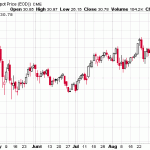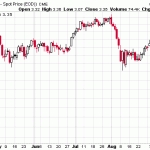While I have been losing a small amount of money on Yellow Media’s preferred shares jaunt to zero, fortunately I have steered far away from Petrobakken (TSX: PBN) which I have written here many times before.
They will not have an easy time renewing their credit facility which expires on June 3, 2012. The debtors are clearly in control of this one, just like how they are in control of Yellow Media. There is $1.14 billion in bank debt at the June 30, 2011 quarterly report. Another looming timeline is a US$750M debenture which holders have a put right – they give notice in December 2012 and the company must redeem at February 8, 2013.
(Update, September 29, 2011: Apparently they managed to renew their credit facility with an extra $150M in the facility… oops! This was announced in their Q2 financial update, which completely escaped me – this kind of blows a hole in the immediacy of cutting the dividend in the subsequent analysis, but there still remains a significant debt renewal of US$750M that will be taking place in February 2013).
From the MD&A, August 9, 2011:
As at June 30, 2011, PetroBakken had $1.14 billion of bank debt drawn on our $1.35 billion credit facility. Our credit facility is with a syndicate of banks and has a maturity date of June 2, 2014. The amount of the facility is based on, among other things, reserves, results from operations, current and forecasted commodity prices and the current economic environment. The credit facility provides that advances may be made by way of direct advances, banker’s acceptances, or standby letters of credit/guarantees. Direct advances bear interest at the bank’s prime lending rate plus an applicable margin for Canadian dollar advances, and at the bank’s US base rate plus an applicable margin for US dollar advances. The applicable margin charged by the bank is based on a sliding scale ratio of PetroBakken’s debt to earnings before interest, taxes, depletion, depreciation and amortization (“EBITDA”). The facility is secured by a $2.0 billion demand debenture and a securities pledge on the Company’s assets. The credit facility has financial covenants that limit the ratio of secured debt to EBITDA to 3:1, limit the ratio of total debt (total debt defined as facility debt plus the value of outstanding debentures in Canadian dollars) to EBITDA to 4:1, and limit secured debt to 50% of total liabilities plus total equity. The Company is in compliance with all of these covenants.
The TTM EBITDA is $659M, thus they are comfortably in compliance with this ratio. You would think the banks would be slightly uncomfortable with lending this much money in a company that is so heavy on capital expenditures.
My immediate guess is that the company will have to seriously curtail, if not outright suspend their dividend until such a time they are able to repay a substantial portion of their credit facility. This is not news to me – I had predicted this in May of 2011.
Another course of action they will likely implement is a slowdown of their capital expenditures. The only consequence of this, however, is that they will not be able to keep up their production levels, which their wells strongly taper off after the first year of drilling. This in turn will hinder their financial results.
The company is also highly sensitive to the price of oil and the past six months of WTIC trading has not helped their cause any.
Even though PBN has been sent down over 50% over the past couple months, it is still trading above my fair value.


